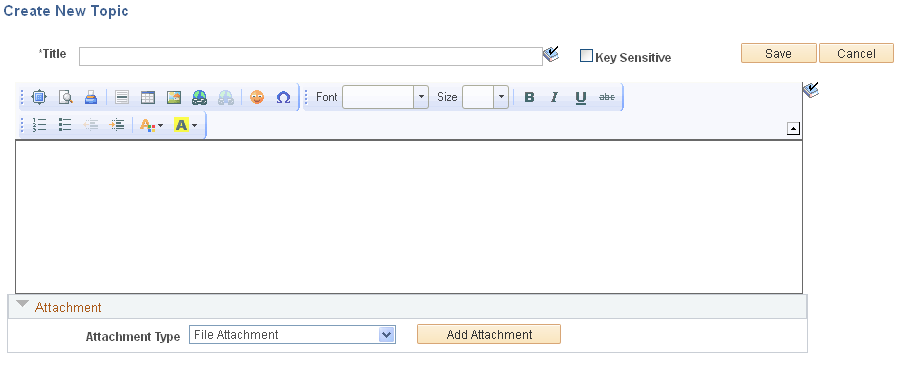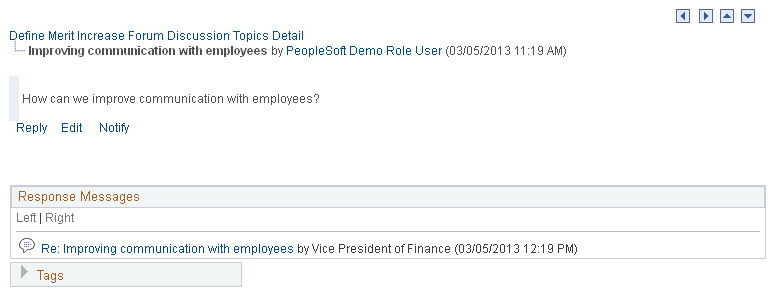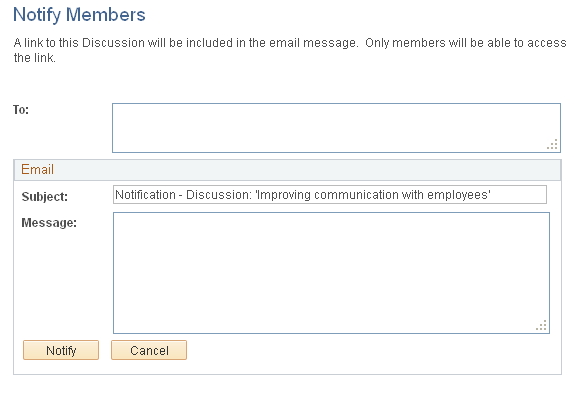Participating in Discussion Forums in the Related Discussion Service
This topic discusses ways to manage discussion posts.
|
Page Name |
Definition Name |
Usage |
|---|---|---|
|
EPPDF_FORUM |
View all forum topics and access features for participating in the forum. |
|
|
Create New Topic |
EPPDF_REPLY_TOPIC |
Add a discussion topic to a discussion forum. |
|
Add a Reply |
EPPDF_REPLY_TOPIC |
Add a reply to a discussion post (topic or reply). The fields on this page are the same as those on the Create New Topic page. |
|
Discussion |
EPPDF_REPLY_TOPIC |
Edit a discussion post (topic or reply). The fields on this page are the same as those on the Create New Topic page. |
|
EPPDF_VIEW_TOPIC |
View details about a discussion post (topic or reply). |
|
|
EPPDF_RCSEARCH |
Review search results and link to discussion posts. |
|
|
EPPDF_VIEW_POLICY |
View the policy for the discussion forum. |
To access a discussion forum in the Related Discussion service, do one of the following:
On the transaction page, select Related Information and then select Related Discussion.
In the related content frame, select the Related Discussion tab.
This example illustrates the fields and controls on the <Discussion Forum> homepage (Related Discussion service). You can find definitions for the fields and controls later on this page.

Use the discussion forum homepage to participate in a forum.
Note: Certain functions are available on this page only if you have been granted contributor or moderator privileges for this forum.
Field or Control |
Description |
|---|---|
<Transaction Page> Forum |
Click the forum title to navigate to the discussion forum homepage. |
Forum Actions |
After selecting this menu, select one of the following forum actions:
|
Linked Posts |
After selecting this menu, select one of the following actions:
|
Search |
Enter the search text. Use * as a wildcard character. |
scope |
Select from the following search scopes:
|
|
Click the Go button to execute the search and view the Search Results page. |
Discussion Topics |
Click the title of a topic to view the details page for that topic. |
Key Sensitive |
This column indicates whether a topic was created as key sensitive, that is, the topic is only available for the specific transaction key or keys. When this column is unselected, the topic is available to all transaction instances. |
|
Click to view the Tags region for the discussion forum. |
Use the Create New Topic page (EPPDF_REPLY_TOPIC) to add a discussion topic to a discussion forum.
Navigation:
Click the Forum Actions menu in the Related Discussion service.
Click the Add Topic link.
Use the Add a Reply page (EPPDF_REPLY_TOPIC) to add a reply to a discussion post (topic or reply).
Navigation:
Click the Reply button on the post details page.
Use the Discussion page (EPPDF_REPLY_TOPIC) to edit a discussion post (topic or reply).
Navigation:
Click the Edit button on the post details page.
This example illustrates the fields and controls on the Create New Topic page (Related Discussion service). You can find definitions for the fields and controls later on this page.

Use the Create New Topic page to add a new discussion topic to a discussion forum.
Use the Add a Reply page to add a reply to any discussion post (topic or reply). The Add a Reply page has the same fields as the Create New Topic page.
Use the Discussion page to edit a discussion post (topic or reply). The Discussion page has the same fields as the Create New Topic page.
Field or Control |
Description |
|---|---|
Title |
Enter a title for your discussion post. |
Key Sensitive |
Select this option to make this post key sensitive, that is, the post is only available for the specific transaction key or keys. Note: To make a post available across all transaction keys (and instances), deselect this option. |
<edit field> |
Use the rich text editor to enter the text of the post. |
Attachment Type |
Select the type of attachment to include with the post:
|
Add Attachment |
If you selected the File Attachment attachment type, click to browse and select the file to upload. |
Select Content |
If you selected the Managed Content attachment type, click to look up the items of managed content available in the content management system. |
Access the Post Details Page (click the link for a post on the discussion forum homepage or in the post details page).
This example illustrates the fields and controls on the Post details page (Related Discussion service). You can find definitions for the fields and controls later on this page.

Use the post details page to view the details about a discussion post (topic or reply).
Field or Control |
Description |
|---|---|
< Transaction Page> Forum Discussion Topics Detail or <Post Title> |
Click to navigate to the discussion forum homepage or to a specific post. |
<Author> |
Click to view the member profile for the author of the current post. |
|
Use the Previous Topic and Next Topic buttons to navigate to the previous or next topic in this forum. Note: Each button is active only when a previous or next topic is available. |
|
Use the Previous Post and Next Post buttons to navigate up and down in the hierarchy of posts for this discussion topic. Note: Each button is active only when a previous or next post is available.. When you view the topic post, click the Previous Post button to navigate to the discussion forum homepage. |
Reply |
Click to access the Add a Reply page to reply to this topic or to this reply. |
Edit |
Click to access the Discussion page to edit this post. |
Notify |
Click to access the Notify Members page to send a notification to forum participants. |
Delete |
Click to delete this post. Any replies to this post will also be deleted. |
|
Click to view the Tags region for the discussion topic. |
Access the Post Details Page for the post that you want to delete.
Note: If the post includes a reply, only the forum moderator can delete the post and any associated replies. The contributor who added the original post will be unable to delete it.
Click the Delete link.
Click OK to confirm that you want to delete that post and any associated replies.
Access the Notify Members Page (click the Notify link on the post details page).
This example illustrates the fields and controls on the Notify Members page (Related Discussion service). You can find definitions for the fields and controls later on this page.

Use the Notify Members page to compose and send an email message to discussion forum participants. The system automatically populates the To field with addresses for all members of the discussion forum who have defined an email address in their system profile.
Note: The email will contain a link to the discussion forum. Only members of the discussion forum will be able to access the forum using the link.
Field or Control |
Description |
|---|---|
To |
Enter additional email addresses for forum participants. Separate email addresses with commas. |
Subject |
Enter a subject for the email. |
Message |
Enter the message text for your email. |
Notify |
Click to send the notification. |
In a discussion forum, you can add and manage tags in the Tags region at two levels:
At the forum level on the discussion forum homepage.
At the topic level on the post details page.
In addition, the Tags region on the discussion forum homepage includes a tag cloud showing all tags (forum level and topic level) added to this discussion forum. The following example shows the Tags region from a discussion forum homepage:
This example illustrates the fields and controls on the Example of a discussion forum homepage (Related Discussion service) showing the Tags region.

In this example, user profile is a tag at the forum level. password, user ID, and general tab were added as tags at the topic level.
Creating, managing, and using tags is discussed in this PeopleBook.
In the Related Discussion service, you can perform three types of searches:
Related Forums: Search in all discussion forums in the Related Discussion service.
Note: Related Forums search is a SQL-based search and does a AND search on all words separated by a space. Ranking is not supported.
Current Forum: Search in this forum only.
Note: Current Forum search is a SQL-based search and does a AND search on all words separated by a space. Ranking is not supported.
EP Forums: Search in all standalone discussion forums in PeopleSoft Interaction Hub.
Note: For the EP Forums search, you must deploy the PAPP_DISCUSSION_POSTS search definition and category of the same name; then build the index. Ranking is supported.
This section discusses how to:
Search in PeopleSoft Interaction Hub forums.
Search for contextual information in related forums.
Related Discussion Service Page
To search in PeopleSoft Interaction Hub forums:
Enter the search text in the Search field in the Related Discussion service.
Use * as a wildcard character.
Select the EP Forums scope.
Click the Go button.
This example shows search text and scope with the cursor over the Go button:

The Search Results page appears. This example shows the results of this search:

Use the Search Results page to review search results, access other posts and forums, and link to discussion posts.
Field or Control
Description
Include Summary
Select this option to show summaries in the search results.
Search Results
Click a link to view that discussion forum and post in the related content frame.
Link It
Important! Link It links appear only for a search type of EP Forums.
Click a Link It link to link the selected post to this discussion forum.
Note: A Link It link does not appear for a post that is already linked to this discussion forum or for the titles of other discussion forums.
Searching for Contextual Information in Related Forums
To search for contextual information, you must map context fields when the Related Discussion service is assigned to a transaction instance.
See Configure Service Page (Related Discussion Service).
To search for contextual information in related forums:
Enter the search text in the Search field in the Related Discussion service.
Use * as a wildcard character.
Select the Related Forums scope.
Click the Go button.
The following example shows search text and scope . In this example, the search term is merit, data that does not occur in the discussion topic title or summary or in the key field for the transaction.

The Search Results page appears. The following example shows the search results. The results include summary information that displays the topic title, topic summary, and context data, such as the key field, and additional context fields. The search term merit occurs in the description field only, which was added as a context field for this transaction.

Use the Search Results page to review search results, access other posts and forums, and link to discussion posts.
Field or Control
Description
Include Summary
Select this option to show summaries in the search results.
Search Results
Click a link to view that discussion forum and post in the related content frame.
To link to a post from an PeopleSoft Interaction Hub discussion forum:
Access the Search Results Page by performing a search in the Related Discussion service.
Note: Select a search scope of EP Forums to access posts that can be linked in the Related Discussion service.
Click a Link It link to link the selected post to this discussion forum.
Use the Forum Policy page (EPPDF_FORUM_POLICY) to enter a policy statement for the discussion forum.
Navigation:
On the Manage Forum page, select the Forum Policy page.
This example illustrates the fields and controls on the Forum Policy Page (viewing).

Use the Forum Policy page to review the policy statement for the discussion forum.

 <Transaction Page> Tags
<Transaction Page> Tags



 Tags
Tags